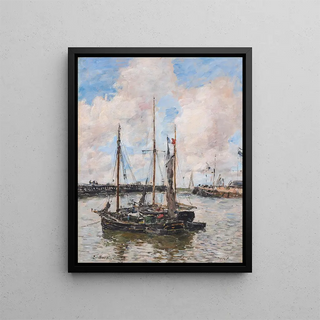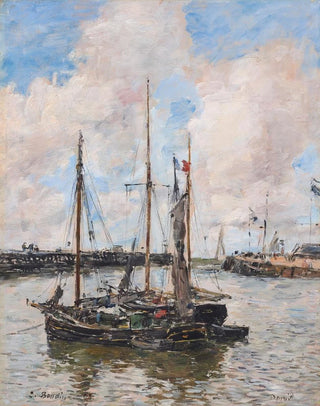Art print | L'entrée du port de Trouville - Eugène Boudin


View from behind

Frame (optional)
The artwork "L'entrée du port de Trouville" by Eugène Boudin is a true invitation to immerse oneself in the lively and luminous atmosphere of the Côte Fleurie. Painted in 1868, this iconic canvas embodies the very essence of the Impressionist movement, long before the term was officially recognized. Through Boudin's attentive gaze, the viewer is transported to the Norman shores, where the sea, sky, and boats blend in a colorful harmony. The scene depicts not only a moment of daily life for fishermen and sailors but also evokes a sense of freedom and movement, capturing the fleeting magic of an ephemeral instant.
Style and uniqueness of the artwork
Boudin's style is distinguished by his ability to play with light and colors. In "L'entrée du port de Trouville," the shades of blue in the sky gently merge with the reflections of the sea, while the white sails of the boats, almost translucent, seem to dance with the wind. The artist employs quick, fluid brushstrokes—a technique that foreshadows the innovations of the Impressionists. This approach makes the work lively, almost tangible, inviting the viewer to feel the sounds of the sea and the smell of salt. Every element of the composition, from clouds to waves, is treated with a lightness that reflects his deep respect for nature and his desire to capture its ephemeral beauty.
The artist and his influence
Eugène Boudin, often considered a precursor to Impressionism, played a crucial role in the evolution of modern painting. Born in 1824 in Honfleur, he spent his life exploring the Norman shores, drawing inspiration from marine landscapes and scenes of daily life. His friendship with Claude Monet and other contemporary artists helped forge a new artistic vision, where light and atmosphere took precedence over realistic representation. Boudin was also a mentor to many young artists, instilling in them the importance of painting en plein air and observing carefully.

Matte finish

View from behind

Frame (optional)
The artwork "L'entrée du port de Trouville" by Eugène Boudin is a true invitation to immerse oneself in the lively and luminous atmosphere of the Côte Fleurie. Painted in 1868, this iconic canvas embodies the very essence of the Impressionist movement, long before the term was officially recognized. Through Boudin's attentive gaze, the viewer is transported to the Norman shores, where the sea, sky, and boats blend in a colorful harmony. The scene depicts not only a moment of daily life for fishermen and sailors but also evokes a sense of freedom and movement, capturing the fleeting magic of an ephemeral instant.
Style and uniqueness of the artwork
Boudin's style is distinguished by his ability to play with light and colors. In "L'entrée du port de Trouville," the shades of blue in the sky gently merge with the reflections of the sea, while the white sails of the boats, almost translucent, seem to dance with the wind. The artist employs quick, fluid brushstrokes—a technique that foreshadows the innovations of the Impressionists. This approach makes the work lively, almost tangible, inviting the viewer to feel the sounds of the sea and the smell of salt. Every element of the composition, from clouds to waves, is treated with a lightness that reflects his deep respect for nature and his desire to capture its ephemeral beauty.
The artist and his influence
Eugène Boudin, often considered a precursor to Impressionism, played a crucial role in the evolution of modern painting. Born in 1824 in Honfleur, he spent his life exploring the Norman shores, drawing inspiration from marine landscapes and scenes of daily life. His friendship with Claude Monet and other contemporary artists helped forge a new artistic vision, where light and atmosphere took precedence over realistic representation. Boudin was also a mentor to many young artists, instilling in them the importance of painting en plein air and observing carefully.






